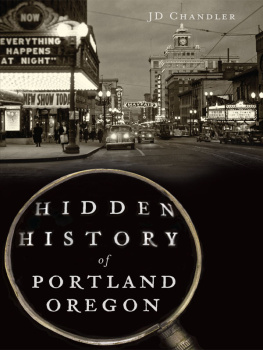

Published by The History Press
Charleston, SC 29403
www.historypress.net
Copyright 2013 by JD Chandler
All rights reserved
Cover images: Front: Portland in the 1870s. Photograph by Joseph Buchtel. Courtesy of oldoregonphotos.com; woman shooting competitor, 1902. Photograph by Walter Bowman. Courtesy of oldoregonphotos.com; John H. Mitchell. Courtesy of offbeatoregon.com; Dong Foot You. Courtesy of Oregon State Archive, Inmate Record #3035.
First published 2013
e-book edition 2013
Manufactured in the United States
ISBN 978.1.61423.896.6
Library of Congress CIP data applied for.
print edition ISBN 978.1.60949.925.9
Notice: The information in this book is true and complete to the best of our knowledge. It is offered without guarantee on the part of the author or The History Press. The author and The History Press disclaim all liability in connection with the use of this book.
All rights reserved. No part of this book may be reproduced or transmitted in any form whatsoever without prior written permission from the publisher except in the case of brief quotations embodied in critical articles and reviews
Contents
Acknowledgements
Writing a book is a very lonely business, but paradoxically it cant be done without support and help from friends and acquaintances. The following people have given invaluable help in preparing this book: Dana Beck, Barney Blalock, Steve Chandler, Cari Eisler, Ken Goldstein, Steve Goldstein, Jim Huff, Finn J.D. John, John Klatt, Dina Lingga, Tom Robinson, Leslie Sand, Jake Warren and Nancy Stewart.
In addition, the following institutions or entities, as well as their staffs, have been of immense help: Multnomah County Central Library, especially the John Wilson Special Collections and the Sterling Writers Room; oldoregonphotos.com; Oregon State Archives; Portland City Archives; Portland Police Museum; and Sellwood-Moreland Improvement League (SMILE).
INTRODUCTION
Ive Been Thinking About Murder Lately
Every neighborhood of a city is haunted by the ghosts of the victims of violent crimes. In my neighborhood on a daily basis, I walk past the tavern where a taxi driver picked up his last fare before being killed for the cash he had collected that night. I walk past several apartment buildings where womenfrom Gwen Ponsson in 1942 to Nikayla Powell in 2012have been killed by lovers or other strangers. I walk past the dumpster where the body of a seven-year-old boy was found thirty years ago and the bowling alley where an employee was shot to death on my last birthday. My neighborhood is not more violent than any of the other neighborhoods in Portland, or any other American city, but it is haunted by countless murder victims. It is probably the most common experience among city dwellers to know about a murder in the neighborhood or to know someone who has been murdered.
No one is immune. Homicide and other violent crimes happen to everyone regardless of gender, ethnicity, occupation, wealth (or its lack) or any other category. A homicide can and does happen to anyone at any time. Thats why it makes such an interesting study. By looking at who has been killed and who has done the killing, we learn about how people lived and died. Sometimes a murder investigation brings to light things that are not remembered anywhere else. By studying the history of murder in a city, we get a glimpse into the lives of its residents, the things they thought about and the problems they faced. By looking at the history of a murder investigation, we learn a lot about the relationship between the citizens and the police force. We learn how the police force and the methods its officers use to enforce the law have changed. Ironically, the study of the history of murder can make the history of a city come alive.
Portland, besides being my favorite city, is a good example of the urban development of the American West. Founded by merchants and real estate developers, Portland has been seen as a city since its first settlement in the 1840s, when it was just a few cabins in an area known as the Clearing. The city was incorporated in 1851, and its first recorded murder occurred just a few weeks later. Portland is not a particularly violent city; in comparison to other American cities, it has always had a modest homicide rate. As the population grew, the murder rate grew with it, reaching a peak in the 1980s and gradually settling into a steady level. Portlands police department has not always been good at solving murders; in fact, sometimes it hasnt even bothered to investigate, but every year skills and technology develop in ways that make it easier to catch killers.
In this book, I have an opportunity to share my obsession with the history of my favorite city and its murders. I hope it will help the history of Portland come alive for my readers. I hope it will give you a glimpse into the dark hearts of the killers and the lost lives of the victims. Most importantly, I hope it will help all of us to remember the people who have come before and lost their lives to the violence of city life. With that in mind, I dedicate this book to the victims of murder, and I hope it will let them live in history and in our memories.
Pioneer Murder, 1858
Just six months after Oregon became a state, Multnomah County executed its first murderer. Danforth Balchs crime, a public shooting in broad daylight, was long remembered as Portlands first murder, but it really wasnt. That dubious honor goes to a man named Cook, who was shot to death at a saloon on Front Street, now Naito Parkway, on April 1, 1851, about six weeks after the city was incorporated. Cook, who was twenty at the time of his death, was killed by William Keene (or Kean) from Missouri. The two men argued in the bar and then shot it out in Wild West fashion. Portland was in Washington County in those days, so Keene was tried in Hillsboro, convicted of manslaughter and sentenced to six months.
The murder of Mortimer Stump by Danforth Balch, while not the first murder in Portland, is the first well-documented case of homicide. It took place on the Stephens ferry at the Westside Stark Street landing on November 18, 1858. Stump was a former employee of Balch, who owned a land grant northwest of Captain Couchs grant, in the west hills of Portland. Stump, whose family lived in East Portland, a separate city in those days, worked on Balchs farm and lived in the Balch home for a few years. In the process, he fell in love with Balchs oldest daughter, Anna. When she was sixteen, Stump went to her father and asked for permission to marry the girl.
Danforth Balch, born in Massachusetts in 1811, came west from Iowa in 1848 and settled on a land grant near Guilds Lake in a neighborhood that became known as Willamette Heights. Balch Creek, which runs through Macleay Park and the Pittock Bird Sanctuary and was once a major logging stream feeding the mills on Portlands waterfront, is on land that once belonged to Danforth Balch. Balch had little education, two or three seasons according to his statement published after his execution, but by 1858, he had a prosperous farm about a mile and a half from Portland and a large family. The thought of his oldest daughter marrying at sixteen seems to have caused him to become unhinged. He fired Stump, threatened to kill him if he came around his daughter and chased him off his land.







